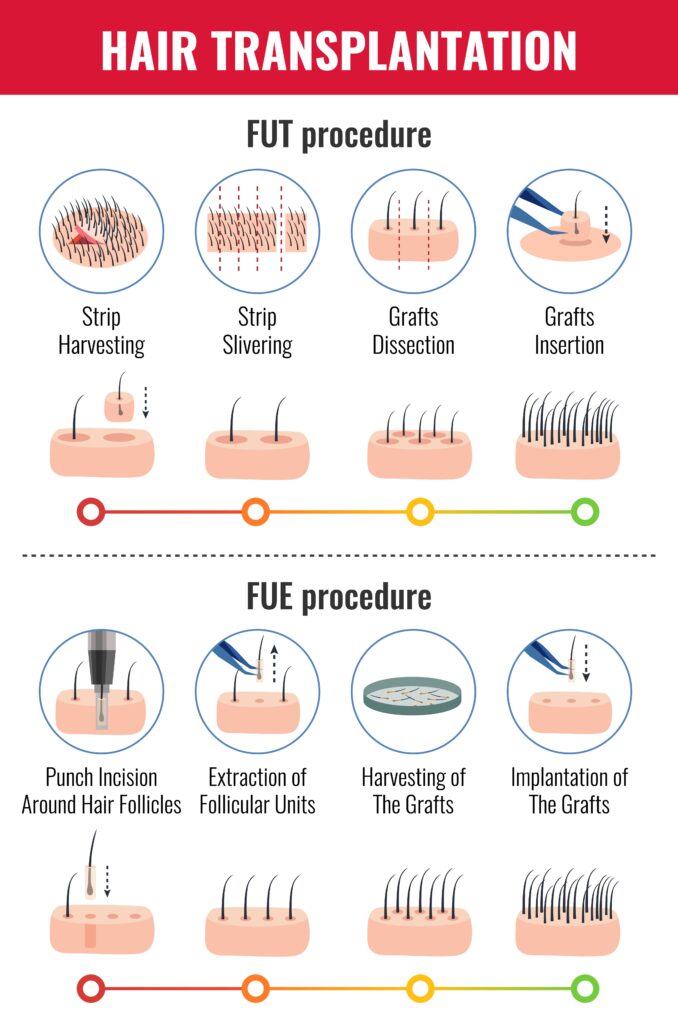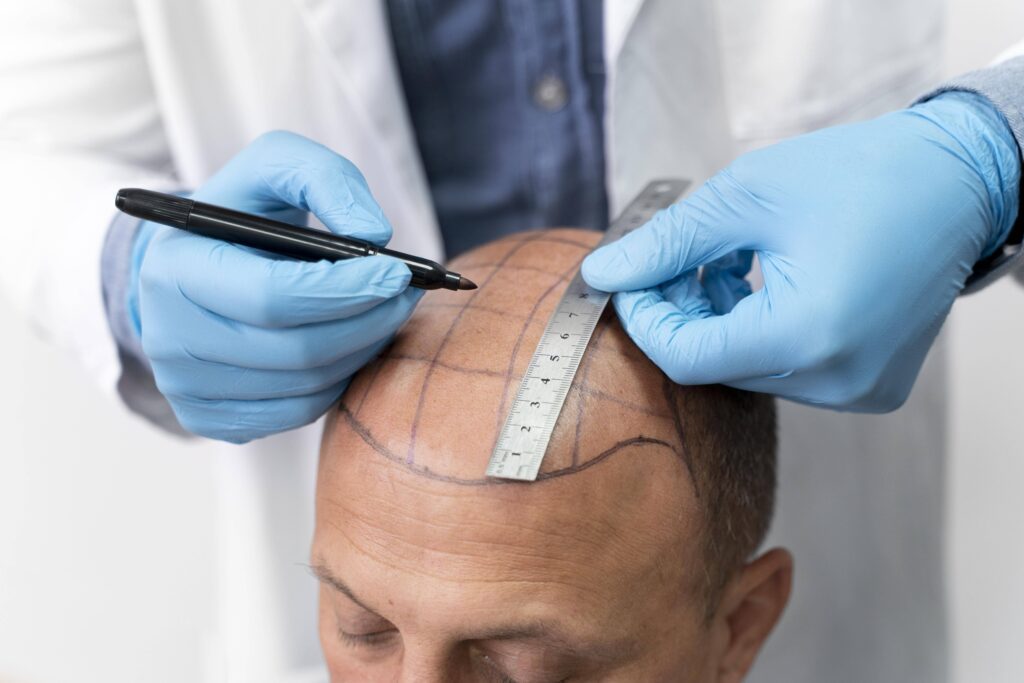If you are looking for an article about “The Ultimate FUE vs. FUT: Which Technique Is Right for You?” then you are in the right place. Millions of people worldwide encounter hair loss as a prevalent concern. With advancements in medical technology, various hair restoration techniques have been developed to help individuals regain their confidence and natural hairline. Two popular methods for hair restoration are Follicular Unit Extraction (FUE) and Follicular Unit Transplantation (FUT). In this article, we will compare these two techniques, highlighting their differences, benefits, and drawbacks, to help you make an informed decision about which method might be best suited for your needs.

Table of Contents
The Ultimate FU vs. FUT: Which Technique Is Right for You?
Follicular Unit Extraction (FUE) and Follicular Unit Transplantation (FUT) are hair transplant methods. FUE involves harvesting individual hair follicles from the donor area, leaving tiny scars, allowing for faster healing. FUT involves removing a strip of scalp, resulting in a linear scar, but enables larger graft quantities. FUE suits those who prefer short haircuts and have a limited donor supply, while FUT is for those needing more grafts and can tolerate a linear scar. Both techniques offer effective hair restoration, but the choice depends on individual preferences and needs.

What is Follicular Unit Extraction (FUE)
FUE is a modern hair restoration technique that involves extracting individual hair follicles from the donor area and implanting them in the recipient area. It is a minimally invasive procedure and is known for its natural-looking results.
The FUE Procedure
During the FUE procedure, a specialized tool is used to extract individual follicular units from the back or sides of the scalp, where hair growth is usually denser. These harvested follicles are then meticulously implanted into the areas experiencing hair loss or thinning.
Advantages of FUE
No linear scarring
Faster healing time compared to FUT
Suitable for patients who prefer to wear short hair
Less postoperative discomfort
What is Follicular Unit Transplantation (FUT)?
FUT, also known as the strip method, involves removing a strip of tissue from the donor area, typically from the back of the scalp. The strip is then dissected into individual follicular units under a microscope before being transplanted into the recipient area.
The FUT Procedure
The FUT procedure begins with the surgeon excising a strip of tissue containing hair follicles from the donor site. The donor area is then sutured, leaving a linear scar, which can be hidden by surrounding hair.
Advantages of FUT
Higher graft survival rate
Perfectly suited for individuals in need of a substantial number of grafts.
Cost-effective for extensive hair restoration
Less time-consuming than FUE for harvesting many grafts
FUE vs. FUT: A Comparative Analysis
Scarring
FUE: No linear scarring, tiny punctate scars that are virtually undetectable.
FUT: Leaves a linear scar, which can be hidden under surrounding hair but may be visible if the hair is cut short.
Healing Time
FUE: Faster healing time due to the minimally invasive nature of the procedure.
FUT: Longer healing time as it involves the removal of a strip of tissue.
Donor Area Considerations
FUE: Suitable for patients with limited donor hair as it allows for targeted extraction.
FUT: Requires a larger donor area, may be challenging for individuals with limited donor hair.
Graft Survival Rate
FUE: Slightly lower graft survival rate due to the handling of individual follicles during extraction.
FUT: Generally has a higher graft survival rate as the follicles are not individually handled.
Naturalness of Results
FUE: Provides natural-looking results, particularly for patients with short hair.
FUT: Also offers natural results, especially for patients with longer hair.
Factors to Consider Before Choosing a Technique
Hair Type and Density
Consider the texture, color, and density of your hair, as this can influence which technique will deliver the most natural-looking results.
Severity of Hair Loss
The extent of your hair loss plays a crucial role in determining the most suitable technique. FUT may be recommended for patients requiring extensive restoration.
Budget and Affordability
Cost can be a significant factor, as FUT is generally more cost-effective for large-scale hair restoration.
Desired Results
Communicate your expectations with your surgeon to ensure they align with the capabilities of the chosen technique.
The Perks and Pitfalls of FUE
Perks
Minimal scarring
Faster healing time
Ideal for short hairstyles
Less postoperative discomfort
Pitfalls
Slightly lower graft survival rate
May be less suitable for extensive hair restoration
Who Should Choose FUE?
FUE is an excellent choice for individuals who prefer to keep their hair short and are concerned about linear scarring. It is also suitable for patients with limited donor hair.
The Perks and Pitfalls of FUT
Perks
Higher graft survival rate
Cost-effective for extensive hair restoration
Less time-consuming for harvesting many grafts
Pitfalls
Leaves a linear scar
Longer healing time
Who Should Choose FUT?
FUT is an excellent option for patients requiring a large number of grafts and those looking for a cost-effective solution for extensive hair restoration.
FUE and FUT Combined: Is It an Option?
The Hybrid Technique
In some cases, a combination of FUE and FUT may be recommended, particularly for patients with significant hair loss and limited donor hair.
Suitability and Advantages
The hybrid technique allows for the harvesting of a large number of grafts from the strip while using FUE to cover any remaining gaps and enhance the naturalness of the hairline.
Conclusion
Follicular Unit Extraction (FUE) and Follicular Unit Transplantation (FUT) stand as efficacious techniques for hair restoration, bearing distinct advantages and drawbacks. FUE suits those preferring minimal scarring and short hairstyles, while FUT is ideal for extensive restoration and cost-effectiveness. Hair type, density, and desired results should guide your choice. A hybrid approach combining both techniques can yield natural-looking results for patients with significant hair loss and limited donor hair. Seeking advice from an expert is essential for tailoring decisions to specific needs. IF you are looking for an article on Best countries for dental tourism, then click the link.
Frequently Asked Questions
How soon will I see results?
Results typically start becoming noticeable after a few months, with full results in around a year.
Can women undergo these procedures?
Yes, both FUE and FUT are suitable for women experiencing hair loss.
Is there a risk of complications?
Like any medical procedure, there are potential risks, but they are minimal and manageable.
Can transplanted hair be styled?
Yes, once the transplanted hair has grown fully, you can style it just like natural hair.
What’s the maintenance required post-transplantation?
Basic hair care maintenance, such as washing and grooming, is all that’s needed.
